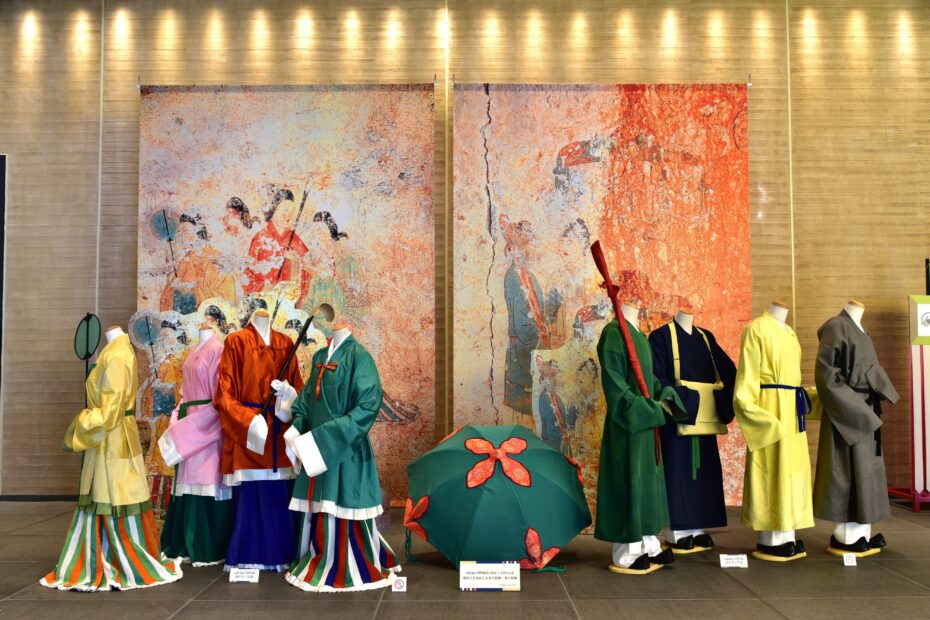[Park Foundation General Incorporated Foundation] 50th Anniversary Special Exhibition: Manyo Costume Exhibition – Revival of Asuka – now being held (Asuka National Park, Asuka Village, Nara Prefecture)
General Incorporated Foundation Parks Foundation Parks Japan.F Press release: November 20, 2024 50th
Anniversary Special Exhibition: Manyo Costume Exhibition – Revival of Asuka – currently being held (Asuka National Park, Asuka Village, Nara Prefecture)
https://prcdn.freetls.fastly.net/release_image/32901/291/32901-291-e8980facdf48da64dbcb88fcbfa568b3-3900×2603.jpg ■It has been 50 years since the Takamatsuzuka Tumulus murals were designated as national treasures. Group images of women and men revived in modern times The Manyo Costume Exhibition – Resurrection of Asuka – is being held at the National Asuka Historical Park Kitora Kofun Museum of the Four Gods from November 12th (Tuesday) to December 15th (Sunday). With the cooperation of Chiyoko Yamaguchi, a Manyo costume designer, we created a book titled “Prince Naka no Oe before the Itsumi Incident”, a major change in the Asuka period. Nakatomi Kamatari,” “Emperor Saimei before the Battle of Shiramurako,” and “Emperor Tenmu and Jito after the Jinshin War,” are displayed in diorama style. We are doing so. In addition, 2020 marks the 50th anniversary of the Takamatsuzuka Tumulus mural painting being designated as a national treasure on April 17, 1972. As this year marks a turning point, we have also recreated the female and male statues on the mural. Also, during the Asuka period, there were various exchanges with China and the countries of the Korean Peninsula. A photo exhibition is currently being held that conveys the similarities between Asuka and Baekje, which are proof of their international connections, and the charm of the Takamatsuzuka Tumulus murals.
https://prcdn.freetls.fastly.net/release_image/32901/291/32901-291-d9a4e2c3e5348dd7795bc810456bb13a-1024×683.jpg ■~Encounter at Tsukinoki Plaza~ Left: Prince Naka no Oe playing kemari Right: Nakatomi Kamatari playing shoes Center: Soga Iruka who does not know his fate Revival of Asuka 1. 644 AD ~Encounter at Tsukinoki Plaza~ Prince Nakano Oeno and Nakatomi Kamatari met for the first time before the Isshi Incident (645), which triggered the Taika Reforms. “Tsuki Tree Square” According to the Nihon Shoki, the plaza is located to the west of Asuka-dera Temple, there is a zelkova tree, and it is said that banquets were held for foreign envoys. When the two met, the prince’s shoe came off and Nakatomi Kamatari picked it up. It is said that this event led to Prince Naka no Oe and Nakatomi Kamatari becoming close friends.
https://prcdn.freetls.fastly.net/release_image/32901/291/32901-291-24c30d1ab3336a67c9d95c9160ba96f5-1024×683.jpg ■Right: King Nukata Center: Emperor Saimei Left: Prince Naka no Oe Revival of Asuka 2. 661 AD ~Emperor Saimei and King Nukata at Nigitatsu~ In 660, Baekje on the Korean peninsula was invaded by Silla and Tang and asked Japan for support. In response to this request for assistance, Japan dispatched its military. At this time, Emperor Saimei, Prince Nakano-oe, and King Nukata-no-okimi were also present. “When a sailor approaches Nigitatsu, he waits for the moon, and the tide is gone, so now he has to start rowing.” (Meaning) As we waited for the moon to set sail at Nikitatsu, the tide finally started to pick up. Now, it’s time to set sail. This song was written in January of the 7th year of Saimei (661 A.D.) on the way to Kyushu, while staying at Nikitatsu (now Matsuyama City, Ehime Prefecture) and planning the timing of the next voyage. . It is also said to be a song of Emperor Saimei. Please note that the background photo is an image.
https://prcdn.freetls.fastly.net/release_image/32901/291/32901-291-aaa43e77312c97b3eed38a8246d798ff-1024×683.jpg ■Hatabata: From left: Byakko, Genbu, Moon statue, Karasugata, Sun statue, Seiryu, Suzaku Front row left: Emperor Jito Front row right Emperor Tenmu Revival of Asuka 3. ~Douban, Emperor Tenmu and Emperor Jito~ After the Jinshin War, Japan became a Ritsuryo state. It symbolically represents the Emperors Tenmu and Jito, who were the driving force behind this movement. The flag was created in the image of the seven flags that were erected in Asaga on New Year’s Day. *According to documents from the Heian period, it is said to be about 9 meters high, but it is unknown what the flag was like in the Asuka period.
https://prcdn.freetls.fastly.net/release_image/32901/291/32901-291-7e60fa8e1a22ae7530b4462e0c7b1eaa-3900×2194.jpg Panoramic view of the photo exhibition venue
https://prcdn.freetls.fastly.net/release_image/32901/291/32901-291-265bd041b22444d9bb837528d1cfbe14-1280×733.jpg A white tiger on the wall painting of Higashihazuka, Baekje. It can be compared with the Kitora tomb mural. Asuka-Baekje connection photo exhibition A photo exhibition is currently being held that conveys the similarities between Asuka and Baekje, which are proof of their international connections, and the charm of the Takamatsuzuka Tumulus murals. Introducing Baekje, which is located in Japan.

This article was partly generated by AI. Some links may contain Ads. Press Release-Informed Article.